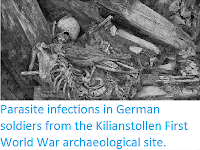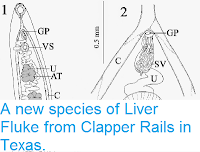New World Terrestrial Flatworms, Geoplanidae, are carnivorous
free-living Platyhelminth Worms found in terrestrial habitats. Like
other Platyhelminths they have a very simple bodyplan, lacking an
internal body cavity which holds the organs or any form of circulatory
system or reproductive organs. They have flattened bodies, which allows
oxygen absorbed through the skin to reach all the cells, with a simple
gut with a single opening that serves as both the mouth and anus. Most
Land Flatworms are extremely limited in their environmental tolerances,
and consequently have very limited geographical ranges, but a few
species have proved to be much more tolerant and have become highly
invasive pest species.
In a paper published in the journal PeerJ on 4 December 2018, Ana Leal-Zanchet and Alessandro Damasceno Marques of the Instituto de Pesquisas de Planárias at the Universidade do Vale do Rio dos Sinos, describe a new species of Terrestrial Flatworm from Minas Gerais State in Brazil.
The new species is described from a single specimen assessed to be a member of the New World Terrestrial Flatworm Family Geoplaninae, on the basis of its subcylindrical body, poorly developed sub-epidermal musculature and a narrow creeping sole. However, it could not be assigned to any previously described genus within that family, and is therefore placed in a new genus, named Difroehlichia, in honour of Claudio Froehlich and the late Eudóxia Froehlich, for their work on the study of terrestrial Flatworms, and given the specific name elenae, in honour of the late Elena Diehl, for her studies of the Ants and Termites of southern Brazil.
Difroehlichia elenae is dark brown in colour and has a length of 13.5 mm and width of 1.5 mm. It has eyes along the margins of both sides of its body, with the exception of the very tip; these are small and monolobate towards the front of the animal and larger and trilobate along the majority of the body, becoming sparse towards the rear. The body is divided into two parts by a muscular, cylindrical pharynx, which is where the mouth is located.
The new species is described from a single specimen assessed to be a member of the New World Terrestrial Flatworm Family Geoplaninae, on the basis of its subcylindrical body, poorly developed sub-epidermal musculature and a narrow creeping sole. However, it could not be assigned to any previously described genus within that family, and is therefore placed in a new genus, named Difroehlichia, in honour of Claudio Froehlich and the late Eudóxia Froehlich, for their work on the study of terrestrial Flatworms, and given the specific name elenae, in honour of the late Elena Diehl, for her studies of the Ants and Termites of southern Brazil.
Difroehlichia elenae is dark brown in colour and has a length of 13.5 mm and width of 1.5 mm. It has eyes along the margins of both sides of its body, with the exception of the very tip; these are small and monolobate towards the front of the animal and larger and trilobate along the majority of the body, becoming sparse towards the rear. The body is divided into two parts by a muscular, cylindrical pharynx, which is where the mouth is located.
Difroehlichia elenae, general dorsal view of preserved specimen. The arrow indicates the anterior extremity. Leal-Zanchet & Marques (2018).
The specimen was found in the entrance to a cave in banded ironstone in an area of cerrado grassland, with a laterite soil and numerous rocky outcrops at the eastern margin of the Serra do Espinhaço Plateau, during the rainy season (November). It appeared to have recently mated and produced eggs, and it is possible that it had come to the cave for this purpose.
Entrance of the ferruginous cave at the basis of a vertical slope in rocky outcrop in the Brazilian where Difroehlichia elenae was discovered. Leal-Zanchet & Marques (2018).
See also...
Follow Sciency Thoughts on Facebook.








